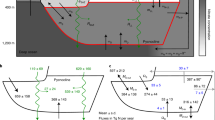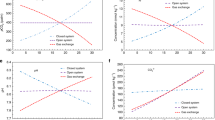Abstract
The ocean's biological pump strips nutrients out of the surface waters and exports them into the thermocline and deep waters. If there were no return path of nutrients from deep waters, the biological pump would eventually deplete the surface waters and thermocline of nutrients; surface biological productivity would plummet. Here we make use of the combined distributions of silicic acid and nitrate to trace the main nutrient return path from deep waters by upwelling in the Southern Ocean1 and subsequent entrainment into subantarctic mode water. We show that the subantarctic mode water, which spreads throughout the entire Southern Hemisphere2,3 and North Atlantic Ocean3, is the main source of nutrients for the thermocline. We also find that an additional return path exists in the northwest corner of the Pacific Ocean, where enhanced vertical mixing, perhaps driven by tides4, brings abyssal nutrients to the surface and supplies them to the thermocline of the North Pacific. Our analysis has important implications for our understanding of large-scale controls on the nature and magnitude of low-latitude biological productivity and its sensitivity to climate change.
This is a preview of subscription content, access via your institution
Access options
Subscribe to this journal
Receive 51 print issues and online access
$199.00 per year
only $3.90 per issue
Buy this article
- Purchase on Springer Link
- Instant access to full article PDF
Prices may be subject to local taxes which are calculated during checkout




Similar content being viewed by others
References
Toggweiler, J. R. & Samuels, B. in The Global Carbon Cycle (ed. Heimann, M.) 333–366 (Springer, Berlin, 1993)
McCartney, M. S. The subtropical recirculation of mode waters. J. Mar. Res. 40 (suppl.), 427–464 (1982)
Sloyan, B. M. & Rintoul, S. R. Circulation, renewal, and modification of Antarctic Mode and Intermediate Water. J. Phys. Oceanogr. 31, 1005–1030 (2001)
Talley, L. D. An Okhotsk Sea water anomaly: Implications for ventilation in the North Pacific. Deep-Sea Res. 38 (suppl. 1), S171–S190 (1991)
Ledwell, J. R., Watson, A. J. & Law, C. S. Evidence for slow mixing across the pycnocline from an open-ocean tracer-release experiment. Nature 364, 701–703 (1993)
Toggweiler, J. R., Dixon, K. & Broecker, W. S. The Peru upwelling and the ventilation of the South Pacific thermocline. J. Geophys. Res. 96, 20467–20497 (1991)
McCartney, M. S. in A Voyage of Discovery (ed. Angel, M. V.) 103–119 (Supplement to Deep-Sea Research, George Deacon 70th Anniversary Volume, Pergamon, Oxford, 1977)
Hanawa, K. & Talley, L. D. in Ocean Circulation and Climate (eds Siedler, G. & Church, J.) 373–386 (Academic, San Diego, 2001)
Ragueneau, O. et al. A review of the Si cycle in the modern ocean: Recent progress and missing gaps in the application of biogenic opal as a paleoproductivity proxy. Glob. Planet. Change 26, 317–365 (2000)
Tsunogai, S. The Western North Pacific playing a key role in global biogeochemical cycles. J. Oceanogr. 58, 245–257 (2002)
Reid, J. L. On the total geostrophic circulation of the Pacific Ocean: Flow patterns, tracers, and transport. Prog. Oceanog. 29, 263–352 (1997)
Talley, L. D. North Pacific Intermediate Water transports in the mixed water region. J. Phys. Oceanogr. 27, 1795–1803 (1997)
Yasuda, I., Kouketsu, S., Katsumata, K. & Ohiwa, M. Influence of Okhotsk Sea Intermediate Water on the Oyashio and North Pacific Intermediate Water. J. Geophys. Res. 107, doi:10.1029/2001JC001037 (2002)
Nakamura, T. et al. The generation of large-amplitude unsteady lee waves by subinertial K1 tidal flow: A possible vertical mixing mechanism in the Kuril Straits. J. Phys. Oceanogr. 30, 1601–1621 (2000)
Yasuda, I. et al. Hydrographic structure and transport of the Oyashio south of Hokkaido and the formation of North Pacific Intermediate Water. J. Geophys. Res. 106, 6931–6942 (2001)
Dugdale, R. C. et al. Meridional asymmetry of source nutrients to the equatorial Pacific upwelling ecosystem and its potential impact on ocean-atmosphere CO2 flux; a data and modeling approach. Deep-Sea Res. II 49, 2513–2531 (2002)
Gnanadesikan, A., Slater, R. D., Gruber, N. & Sarmiento, J. L. Oceanic vertical exchange and new production: A comparison between models and observations. Deep-Sea Res. II 49, 363–401 (2002)
Sigman, D. M., Altabet, M. A., McCorkle, D. C., Francois, R. & Fischer, G. The δ15N of nitrate in the Southern Ocean: Consumption of nitrate in surface waters. Glob. Biogeochem. Cycles 13, 1149–1166 (1999)
Franck, V. M., Brzezinski, M. A., Coale, K. H. & Nelson, D. M. Iron and silicic acid concentrations regulate Si uptake north and south of the Polar Frontal Zone in the Pacific Sector of the Southern Ocean. Deep-Sea Res. II 47, 3315–3338 (2000)
Brzezinski, M. A., Dickson, M.-L., Nelson, D. M. & Sambrotto, R. Ratios of Si, C and N uptake by microplankton in the Southern Ocean. Deep-Sea Res. II 50, 619–633 (2003)
Pollard, R. T., Lucas, M. I. & Read, J. F. Physical controls on biogeochemical zonation in the Southern Ocean. Deep-Sea Res. II 49, 3289–3305 (2002)
Sarmiento, J. L., Hughes, T. M. C., Stouffer, R. J. & Manabe, S. Simulated response of the ocean carbon cycle to anthropogenic climate warming. Nature 393, 245–249 (1998)
Sigman, D. M. & Boyle, E. A. Glacial/interglacial variations in atmospheric carbon dioxide. Nature 407, 859–869 (2000)
Speer, K., Rintoul, S. R. & Sloyan, B. The diabatic Deacon Cell. J. Phys. Oceanogr. 30, 3212–3222 (2000)
Sarmiento, J. L. et al. A new estimate of the CaCO3 to organic carbon export ratio. Glob. Biogeochem. Cycles 16, doi:1029/2002GB00191 (2002)
Moore, J. K., Abbott, M. R. & Richman, J. G. Location and dynamics of the Antarctic Polar Front from satellite sea surface temperature data. J. Geophys. Res. 104, 3059–3073 (1999)
Belkin, I. M. & Gordon, A. L. Southern Ocean fronts from the Greenwich meridian to Tasmania. J. Geophys. Res. 101, 3675–3696 (1996)
Levitus, S. et al. World Ocean Database 1998 Vol. 1, Introduction (NOAA NESDIS, Washington DC, 1998)
Kara, A. B., Rochford, P. A. & Hurlburt, H. E. Mixed layer depth variability over the global ocean. J. Geophys. Res. 108, doi:10.1029/2000C000736 (2003)
Gruber, N. & Sarmiento, J. L. Global patterns of marine nitrogen fixation and denitrification. Glob. Biogeochem. Cycles 11, 235–266 (1997)
Acknowledgements
We thank I. Belkin and K. Moore for making their frontal paths in the Southern Ocean available to us. This paper benefited from comments by M. Bender, B. McNeil, D. Sigman, C. Sweeney and R. Toggweiler. J.L.S. was supported by a NOAA Office of Global Programs grant to the Carbon Modeling Consortium for model development, and by an NSF grant for model and observational interpretations as part of the JGOFS Synthesis and Modeling Project. J.L.S. and J.D. were supported by a DOE Office of Science grant for the nutrient depletion scenarios. N.G. was supported by the DOE, and M.A.B. by the NSF.
Author information
Authors and Affiliations
Corresponding author
Ethics declarations
Competing interests
The authors declare that they have no competing financial interests.
Rights and permissions
About this article
Cite this article
Sarmiento, J., Gruber, N., Brzezinski, M. et al. High-latitude controls of thermocline nutrients and low latitude biological productivity. Nature 427, 56–60 (2004). https://doi.org/10.1038/nature02127
Received:
Accepted:
Issue Date:
DOI: https://doi.org/10.1038/nature02127
This article is cited by
-
Oxygen isotope constraints on the ventilation of the modern and glacial Pacific
Climate Dynamics (2024)
-
Spatiotemporal high-resolution mapping of biological production in the Southern Ocean
Communications Earth & Environment (2023)
-
Present-day North Atlantic salinity constrains future warming of the Northern Hemisphere
Nature Climate Change (2023)
-
Southern Ocean glacial conditions and their influence on deglacial events
Nature Reviews Earth & Environment (2023)
-
Regional and global impact of CO2 uptake in the Benguela Upwelling System through preformed nutrients
Nature Communications (2023)
Comments
By submitting a comment you agree to abide by our Terms and Community Guidelines. If you find something abusive or that does not comply with our terms or guidelines please flag it as inappropriate.



